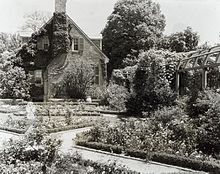| Charles Gillette | |
|---|---|
| Born | March 14, 1886 Chippewa Falls, Wisconsin |
| Died | March 30, 1969 Richmond, Virginia |
| Nationality | American |
| Occupation | Architect |
| Spouse |
Ellen Patterson Cogwell
(m. 1912; died 1967) |
| Projects | University of Richmond, Reynolds Metals Company International Headquarters |
Charles Freeman Gillette (March 14, 1886 – March 30, 1969) was a prominent landscape architect in the upper South who specialized in the creation of grounds supporting Colonial Revival architecture, particularly in Richmond, Virginia. He is associated with the restoration and re-creation of historic gardens in the upper South and especially Virginia. He is known for having established a regional style—known as the "Virginia Garden."
Biography

Charles F. Gillette was born in Chippewa Falls, Wisconsin in 1886 as the tenth and last child of Orlando Gillette and Catherine Gillette (nee Melville). His father served as a private in the 30th Wisconsin Infantry Regiment in the Union Army during the Civil War. Due to his family's financial state, Gillette never had any formal schooling.
In 1909–1911, Gillette served as an apprentice in the Boston office of Warren H. Manning, a leading early-20th century landscape architect. Gillette moved to Richmond in 1913 to supervise the completion of Manning's landscape design for the University of Richmond's new campus. In 1915, he began designing the grounds of the Nelson House in Yorktown, Virginia. In 1924, he commenced work on the landscape restoration of Kenmore in Fredericksburg, Virginia. A few years later, he initiated plans for the landscaping of Virginia House and Agecroft, both reconstructed English manor houses located in Richmond's Windsor Farms neighborhood. Extensive additions to the Virginia House gardens were completed in 1939. During the 1950s, Gillette redesigned the gardens of Virginia's Executive Mansion at the request of Governor Thomas B. Stanley. In 1958, he designed the grounds for the Reynolds Metals Company International Headquarters located at Richmond. His commissions also included hundreds of residential projects throughout Virginia and North Carolina.
A number of his works were designed for properties listed on the National Register of Historic Places.
In popular culture
Author Tom Wolfe references Gillette as the commissioned landscaper of Dupont University in I Am Charlotte Simmons.
Selected works
- University of Richmond (1913), Richmond, VA
- Nelson House (1915), Yorktown, Virginia
- Casa Maria (1921-1922), Greenwood, VA
- Blue Ridge Farm (1923-1924), Greenwood, VA
- Sunken Garden (Virginia) (1923-1924), Williamsburg, Virginia
- Kenmore (1924), Fredericksburg, Virginia
- Agecroft Hall (1926), Richmond, VA
- MacCallum More and Hudgins House Historic District gardens (1927), Chase City, Virginia
- Belfield (1929-1930), Lexington, Virginia
- Gallison Hall (1931-1933), Charlottesville, VA
- Windemere (1860), Richmond, VA
- Midway (Millington, Virginia) (1936), Millington, VA
- Reynolds Metals Company International Headquarters (1958), Richmond, VA
- Lewis Ginter Botanical Garden, Richmond, VA
- Glen Alpine in the Cifax Rural Historic District, Cifax, Virginia
- Oak Grove (Eastville, Virginia), Eastville, VA
- E. Hervey Evans House (1939), Laurinburg, NC
- Monroe Ward, Richmond, VA
- John Whitworth House, Richmond, VA
- Longview Gardens Historic District
- Meadowbrook
- Virginia House, 1927
- Elderslie, 1917
- 4300 Sulgrave Road, 1957
- Executive Mansion (Virginia), 1954
- Nordley (4203 Sulgrave Road), 1924
- Redesdale, 1925
- Little Yatton, Orange County, 1948
- Meadowfarm, Orange County, 1934
References
- Library of Virginia: About the Charles F. Gillette Photograph Collection
- "National Register Information System". National Register of Historic Places. National Park Service. July 9, 2010.